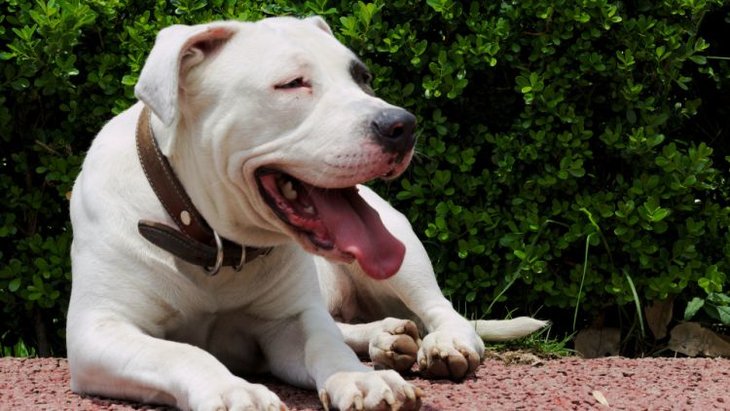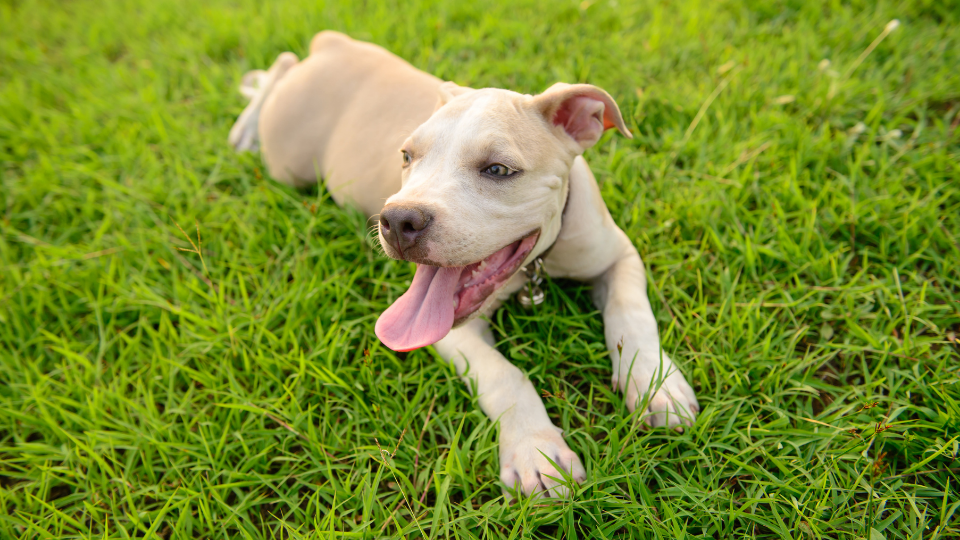Pit Bull Growth & Weight Chart: Everything You Need to Know
Cornell University College of Veterinary Medicine
Known for their fierce strength and athleticism, Pit Bulls are courageous dogs with a loving, gentle side. Pit Bulls are a mix between bull and terrier dogs and are solidly built, short-coated with robust bodies. These dogs are amazingly versatile and used in police work, hunting, drug detection, water safety, therapy, and more! They are reliable, fiercely loyal dogs that make wonderful additions to many families.
Your new puppy may be small — but their vet bills won't be.
Save big on costs with pet insurance, so you can protect your puppy while protecting your wallet.
If you’re the lucky pet parent to one of these confident, hard-working dogs, you may be wondering how big will my Pit Bull get and when will they stop growing?
Here's everything you need to know about Pit Bull growth:
Pit Bull Growth & Weight
“Pit Bull” is a general term that applies to several bulldog and terrier mixes, including the American Pit Bull Terrier and Staffordshire Bull Terrier. The following Pit Bull growth and weight charts reflect an American Pit Bull Terrier’s estimated weight. Staffordshire Bull Terriers tend to be smaller than Pit Bulls, weighing between 25 and 40 pounds, putting them on the smaller end of these estimates.
Please keep in mind that the following numbers are estimates. All puppies grow at their own rate, and the Pit Bull breed is prone to significant variances in their final size. If you are concerned that your Pit Bull is significantly ahead or behind of the following numbers, please consult with your veterinarian so they can give you personalized advice on your pup’s growth and weight.
Pit Bull Growth and Weight Chart
Age | Male Weight | Female Weight |
|---|---|---|
1 month old | 3 - 5 lbs | 2 - 4 lbs |
2 months old | 5 - 15 lbs | 5 - 15 lbs |
3 months old | 10 - 20 lbs | 10 - 20 lbs |
4 months old | 15 - 25 lbs | 10 - 20 lbs |
5 months old | 15 - 30 lbs | 15 - 25 lbs |
6 months old | 20 - 35 lbs | 15 - 30 lbs |
7 months old | 20 - 40 lbs | 15 - 35 lbs |
8 months old | 25 - 45 lbs | 20 - 35 lbs |
9 months old | 25 - 50 lbs | 20 - 40 lbs |
10 months old | 25 - 50 lbs | 25 - 40 lbs |
11 months old | 30 - 55 lbs | 25 - 45 lbs |
12 months old | 30 - 55 lbs | 25 - 45 lbs |
2 years old | 35 - 60 lbs | 30 - 50 lbs |
At what age is a Pit Bull fully grown?
As medium-sized dogs, Pit Bulls need around a year to reach their full size. Larger Pit Bulls may require a full 18 months to fill out their chest fully.

How big should a 6-month-old Pit Bull be?
There is a lot of variation within the Pit Bull breed regarding their size and weight. At 6-months-old, a female Pit Bull will likely be around 15 to 30 pounds. Comparatively, a male Pit Bull pup at the same age will be approximately 20 to 35 pounds.
Please remember that these are estimates, and your puppy will grow at their own unique rate.
💡 Pro Tip: Read our new puppy checklist for tips on how to set up a vaccination schedule, wellness plan, microchips, things to have on hand for your puppy, and more.
How much bigger will my Pit Bull get?
There are a few ways to estimate how much bigger your Pit Bull will get.
First, start with your Pit Bull puppy’s age. If your pup is less than a year old, they are likely still growing. Most Pit Bull puppies will be at their adult size or close to it on their first birthday. Between 12 months of age and 18 months of age, you may notice your Pit Bull puppy filling out their chest a little more, but they should not be putting on significant weight after their first birthday.
You can also take a look at your puppy’s paws. If your Pit Bull pup’s paws are oversized next to their legs and body, they are likely still growing as this is a classic puppy feature indicating that they are still filling out.
Lastly, if you purchased your Pit Bull through a breeder, you can reach out to them for more information on your pup’s estimated adult size. Based on your pup’s parents and past litters, your breeder should be able to provide you with a more precise estimate of how big your Pit Bull puppy may grow to be.

What is the size of a full-grown Pit Bull?
According to the United Kennel Club Pit Bull Breed Standards, a male American Pit Bull Terrier should ideally weigh between 35 and 60 pounds and stand 18 to 21 inches when measured from the floor to the shoulders. A female American Pit Bull Terrier is slightly smaller and should weigh closer to 30 to 50 pounds and stand 17 to 20 inches at the shoulders.
Pit Bull is a general term for a bulldog and terrier mix that is most commonly used in reference to the American Pit Bull Terrier. Staffordshire Bull Terriers are also referred to as Pit Bulls and are smaller, with most males weighing between 28 and 38 pounds and females weighing in at 24 to 34 pounds. According to the American Kennel Club, Staffordshire Bull Terriers will also be slightly shorter at 14 to 16 inches tall.
Learn all about your puppy's physical characteristics, breed history, personality traits, and more in our comprehensive guide.
How do I make sure my Pit Bull is healthy?
As beloved members of the family, we want the best for our Pit Bulls, and their health plays a significant role in their happiness and overall wellbeing. Preventative care is always better than treatment when it comes to caring for our dogs. Routine veterinary exams, screenings, blood work, and vaccinations are important ways to help our Pit Bulls avoid or minimize health issues later on. Your pit bull puppy will need several vaccinations in their first 6 months of life, and then should be seen at least once a year for a routine health exam.
Pit Bulls are more susceptible to various health issues, including allergies, torn knee ligaments, thyroid problems, hip dysplasia, cataracts, and more. Allergies, also known as “atopy,” are more common in Pit Bulls. Unlike humans who sneeze and have watery eyes in response to an allergen, dogs will often have itchy skin. Frequent ear infections, excessive rubbing of the face, and licking the paws are all signs that your dog may be suffering from allergies. There are various ways to treat allergies, so if you notice your pup is struggling with allergies, consult with your veterinarian for your next steps.
💡 Pro Tip: Ready to be reimbursed for up to 100% of your dog’s veterinary bills whenever they are sick or injured? Get pet insurance today.
Pit Bull Veterinary Costs
Many health problems can be treated, eased, or avoided entirely with preventative care. Unfortunately, veterinary care is becoming more expensive, making it difficult for many pet parents to regularly take their beloved pets to the veterinarian. If your pet develops a health issue, it can easily cost thousands of dollars to treat. For example, Pit Bulls are more prone to developing cataracts, and the typical treatment, cataract surgery, costs between $2,700 to $4,000 on average. When surveyed, only 1 in 5 pet parents said they would be able to pay for a $5,000 veterinary expense out-of-pocket, which leaves many pet parents in a pinch if their pup needs surgery or veterinary treatments. This is why pet insurance is so important.
Pet insurance works by reimbursing you for up to 90% of out-of-pocket veterinary expenses, which gives you peace of mind should the worst happen to your pup. Like us, our dogs are living longer and longer lives and will need ongoing veterinary care to have the best quality of life possible. Pet insurance gives you a safety net should your Pit Bull develop an illness or become injured. With pet insurance, you and your veterinarian can focus on providing your pup with the best veterinary care possible without worrying about the cost.
Some people can predict the future.For everyone else, there's pet insurance.
Key Takeaways
- A full-grown American Pit Bull Terrier stands 17-21 inches tall and weighs between 35-60 pounds (males) or 30-50 pounds (females).
- Pit Bull puppies usually stop growing around 18 months-old, but looking at the size of their paws can help you tell how much bigger they might get.
- As a breed, Pits are known to develop certain congenital conditions, including severe allergies and frequent ear infections.
- Pet insurance is a resource owners can use to offset the cost of keeping their new Pit puppy happy and healthy.
Do you want to find the best pet insurance?
Let's analyze your pet's breed, age, and location to find the right coverage and the best savings. Ready?
Analyze My PetAbout Pawlicy Advisor
The pet insurance marketplace endorsed by veterinarians, at Pawlicy Advisor we make buying the best pet insurance easier. By comparing personalized coverage and pricing differences we can save you a ton of money, up to 83% in some instances!
Instantly Compare Pet Insurance Plans
Guides
Determine If Pet Insurance Is Worth It
Comparison Charts
Find Your State
Dog Insurance
Cornell University College of Veterinary Medicine
Aliyah Diamond has more than ten years of experience in animal hospitals - working with dozens of species from dogs and cats, to elephants and snow leopards. Her lifelong passion for helping animals currently has her earning her doctorate of veterinary medicine at Cornell University and helping Pawlicy Advisor educate pet parents.
